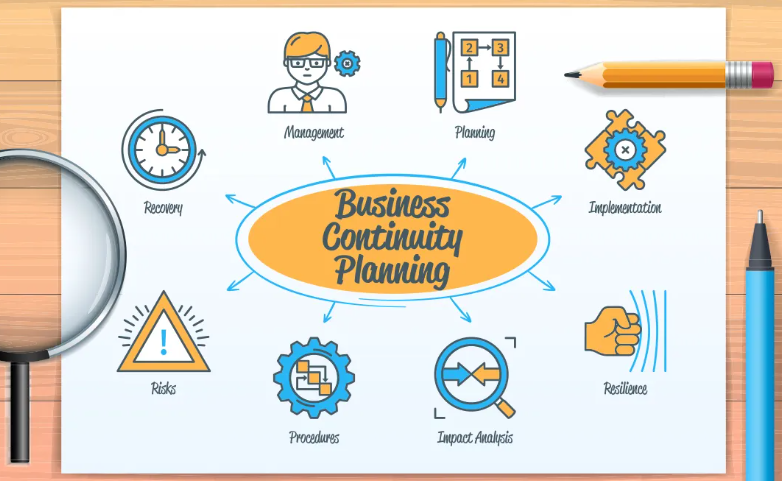In today’s rapidly changing world, businesses of all sizes face a variety of threats ranging from natural disasters to cyberattacks. A well-crafted business plan continuity strategy is essential for ensuring that operations can continue during and after a crisis. This guide will walk you through how to develop a business continuity plan that protects your assets, staff, and reputation.
Contents
- 1 What is a Business Plan Continuity Strategy?
- 2 Why You Need a Business Continuity Plan
- 3 Step-by-Step Guide to Developing a Business Plan Continuity Strategy
- 3.1 Step 1: Establish a Business Continuity Team
- 3.2 Step 2: Conduct a Business Impact Analysis (BIA)
- 3.3 Step 3: Perform a Risk Assessment
- 3.4 Step 4: Identify Critical Business Functions
- 3.5 Step 5: Develop Recovery Strategies
- 3.6 Step 6: Create a Communication Plan
- 3.7 Step 7: Document the Plan
- 3.8 Step 8: Train Employees
- 3.9 Step 9: Test and Update the Plan Regularly
- 4 Tools and Templates for Business Plan Continuity
- 5 Sample Business Continuity Plan Template
- 6 Common Mistakes to Avoid
- 7 Final Thoughts
What is a Business Plan Continuity Strategy?

Business plan continuity, also known as business continuity planning (BCP), refers to the process of creating a system that helps a company respond to and recover from potential disruptions. The goal is to minimize downtime and ensure that critical business functions continue even under adverse conditions.
Why You Need a Business Continuity Plan
Having a business plan continuity strategy is no longer optional. Whether you’re a startup, a small business, or a multinational corporation, disruptions can have a devastating effect on your operations, finances, and customer trust. Here are some key reasons why you need a continuity plan:
- Reduce Downtime: Keeps your business running even during disasters.
- Protect Revenue: Avoid significant financial losses.
- Maintain Customer Trust: Show clients and customers that you’re prepared.
- Comply with Regulations: Meet legal and industry standards.
- Improve Risk Management: Understand and mitigate risks proactively.
Step-by-Step Guide to Developing a Business Plan Continuity Strategy
Step 1: Establish a Business Continuity Team
Create a dedicated team responsible for managing your business plan continuity strategy. Include members from various departments—IT, HR, finance, operations, and management.
Key Roles:
- BCP Coordinator: Oversees the plan’s development and execution.
- Department Leads: Provide input on critical functions and processes.
- IT Specialists: Ensure technology continuity.
Step 2: Conduct a Business Impact Analysis (BIA)
A BIA identifies the effects of disruption on your business operations. This step helps determine:
- Which processes are essential
- The acceptable amount of downtime (Recovery Time Objective – RTO)
- The maximum tolerable data loss (Recovery Point Objective – RPO)
Questions to Ask:
- Which processes are mission-critical?
- How long can these processes be unavailable?
- What dependencies are associated with each process?
Step 3: Perform a Risk Assessment
Evaluate internal and external threats to your business.
Common Risks:
- Natural disasters (earthquakes, floods)
- Cybersecurity attacks (ransomware, data breaches)
- Equipment failure
- Supply chain disruptions
- Pandemics
Assign a risk rating (low, medium, high) to each threat based on likelihood and impact.
Step 4: Identify Critical Business Functions
Not all business functions are equally important. Identify which processes must continue under all circumstances.
Examples:
- Payroll
- Customer service
- Order processing
- IT support
Step 5: Develop Recovery Strategies
For each critical function, outline how it will be restored. Include contingency plans for employees, IT systems, and business locations.
Recovery Strategy Examples:
- Remote work protocols
- Cloud-based data backups
- Temporary office spaces
- Manual workarounds
Step 6: Create a Communication Plan
Clear communication is vital during a disruption. Your communication plan should cover:
- Employee notification procedures
- Customer updates
- Stakeholder communication
Include:
- Emergency contact lists
- Pre-written templates
- Designated spokespersons
Step 7: Document the Plan
Write down all the strategies and procedures in a formal document. Your business plan continuity document should include:
- Executive summary
- BIA and risk assessment results
- Recovery plans
- Contact lists
- Roles and responsibilities
Store copies in multiple secure locations, including cloud-based storage.
Step 8: Train Employees
Everyone in your organization should understand their role during an emergency. Conduct regular training and simulations to keep staff prepared.
Training Tips:
- Host workshops and webinars
- Use real-life scenarios
- Schedule annual drills
Step 9: Test and Update the Plan Regularly
Business environments change constantly. Test your plan at least once a year and update it to reflect:
- Organizational changes
- New technologies
- Lessons from past incidents
Testing Methods:
- Tabletop exercises
- Full-scale simulations
- Surprise drills
Tools and Templates for Business Plan Continuity
Several tools can make developing a business plan continuity strategy easier:
- Ready.gov BCP Toolkit
- FEMA Business Continuity Planning Suite
- ISO 22301 Compliance Templates
- Microsoft 365 and Google Workspace for cloud collaboration
Sample Business Continuity Plan Template
1. Executive Summary
Brief overview of your business and the purpose of the BCP.
2. Objectives
What the plan aims to achieve.
3. Key Contacts
List of emergency contacts and roles.
4. Business Impact Analysis Summary
Top critical processes and systems.
5. Risk Assessment Summary
Key threats and risk ratings.
6. Recovery Strategies
Detailed plans for process, data, and infrastructure recovery.
7. Communication Plan
Who communicates what, when, and how.
8. Training and Testing Procedures
How the plan will be maintained and tested.
Common Mistakes to Avoid
- Not involving all departments
- Failing to test the plan
- Ignoring supply chain risks
- Poor communication
- Neglecting cybersecurity preparedness
Final Thoughts
A strong business plan continuity strategy is a critical investment in your company’s future. By preparing for disruptions before they occur, you can minimize downtime, protect your reputation, and recover faster. Remember, continuity planning is not a one-time project but an ongoing commitment to resilience.
